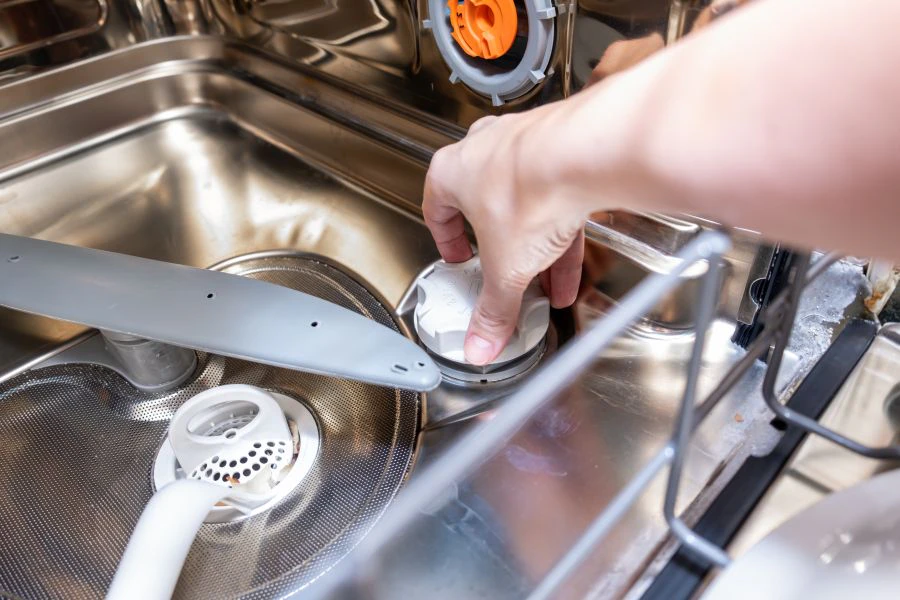
Home appliances
Tips to optimize the use of my dishwasher
After years of doing the dishes by hand, the revolution is finally coming to your home: a dishwasher! Often, the first few weeks, the enthusiasm is so present that we tend to run it very regularly, for the pleasure of having permanently clean dishes. But over time, we come to understand that there are more efficient methods than others to use a dishwasher effectively.
Indeed, the performance of this household appliance depends, of course, on the model with which you are equipped. But they can also vary greatly depending on how you use it. To get the most out of your dishwasher's performance, here are some tips to apply.

When loading your dishwasher
Remove leftovers from plates
One can easily be tempted to think that the dishwasher can take care of everything, including cleaning the remains stuck in the plates. While it is possible that the appliance can do this, the fact is that it can limit the cleanliness of the dishes after the cycle. Also, food scraps fall to the bottom of the dishwasher and they can rot there if you don't remove them.
The ideal is therefore to quickly rinse the really dirty plates before putting them in the dishwasher, a gesture that takes a few seconds and which can save you a lot of maintenance time afterwards.
Position cutlery correctly
Contrary to what one might think, you have to put the knives point down in the cutlery basket of the dishwasher, which avoids hurting yourself by taking them out after the cycle. But not only that, it is much more hygienic to hold them by the handle rather than by the tip to store them! An argument that is, by the way, also valid for forks and spoons.
Also remember to separate the cutlery if you have it in different materials. Do not wash steel utensils together with silver ones, put them in separate spaces of the basket.
Be strategist with the dishes
The plates are placed in the spaces provided for this purpose and they must be systematically turned towards the interior of the dishwasher to benefit from optimal cleaning. Put your dishes and pots on the lower level and turn them over to allow the water to drain easily.
The glasses are to be positioned in the upper level of the appliance, facing down, to prevent water from stagnating. In the center of this level, you can install your dirtiest dishes, since this is where the water jets are the most powerful. For the same reason, avoid putting your most fragile dishes in it. Instead, find a place for it in one of the corners of the lower floor.
Check the operation of the spray arms
Before you start your dishwasher, it is worth checking that the spray arms on it can spin properly. There are usually two arms, one at the top and one at the bottom inside the device. When the program is started, the arms rotate and spray water on the dirty dishes. If an arm is blocked, for example by an overhanging cutlery, not only can this limit the effectiveness of the cleaning, but it can also damage your machine.
Do not hesitate to manually turn each arm to check that it is free to move before closing your dishwasher.


Use the right program
It is a safe bet that your dishwasher has at least half a dozen different programs. Perhaps you are tempted to choose one and use it systematically, for simplicity reason. However, this could be a mistake. If you use a quick program on heavily soiled dishes, you may get a disappointing result that will require a second cleaning session.
Likewise, using a long cycle for everyday dishes is usually not helpful, in addition to using more water and electricity. It is better to adapt the program to the context to take advantage of the right balance between cleanliness of the dishes and use of your appliance. After a few weeks, you will undoubtedly know the programs by heart!
When emptying the dishwasher
Do things in the right order
Emptying a dishwasher is quite an art, especially if you do not want to have to wipe your clean dishes more than necessary! After the cycle is over, start by opening the dishwasher to let the steam out. After a few minutes, you can empty your device, starting with the bottom drawer. This saves you from taking the risk of wetting its contents by pulling the top drawer towards you.
The cutlery basket can be lifted to be emptied close to your drawer. It may be obvious to you, but many dishwasher owners do not have this very useful reflex! Once you are done with the bottom drawer, take care of the top one quietly.


Add some (water softener) salt
When your dishwasher is empty, you have easy access to the water softener salt reservoir. This is therefore the perfect time to check if there is still enough for the next cleaning cycles. You may be tempted not to use any, but then you risk frequently finding traces of limescale on your freshly washed dishes. If your running water is hard, do not neglect the salt.
Ideally, use regeneration salt composed of at least 99.5% sodium chloride (NaCI). This information is displayed on the product packaging. It is recommended to refill the salt compartment at least once a month.
Dishwasher maintenance
Do a thorough cleaning regularly
Your dishwasher cleans your dishes. But who cleans your dishwasher? It is you ! It is necessary, once a month at least, to carry out a complete maintenance of the device. Empty and clean the filter in the bottom of the tank, clean and dry the door gaskets, and make sure that the holes in the spray arms are not clogged.
This manual maintenance also allows you to check that the water is draining well and that your dishwasher does not have a problem. Do not wait until your dishes come out dirty from a cycle to be sure.
Run the dishwasher washing cycle when it is empty
Cleaning the dishwasher tub from top to bottom by hand is a chore that can easily be dispensed with. To do this, put a bowl of white vinegar in the upper part of the device. Then launch a long empty cycle. The vinegar will mix with the cleaning water and it will degrease and clean the walls, in addition to preventing the deposit of scale. At the end of the washing cycle, open the dishwasher to dry it and remove any loose residue with a sponge.
With these tips, you should not only enjoy consistently clean dishes, but also a well-maintained dishwasher with an extended lifespan. It is therefore worth applying them without further delay!



 Canada (English)
Canada (English)  México (Español)
México (Español)  USA (English)
USA (English)  América Central y el Caribe (Español)
América Central y el Caribe (Español)  Argentina (español)
Argentina (español)  Bolivia (español)
Bolivia (español)  Chile (español)
Chile (español)  Colombia (español)
Colombia (español)  Equador (español)
Equador (español)  Deutschland (Deutsch)
Deutschland (Deutsch)  France (Français)
France (Français)  Nederland (Nederlands)
Nederland (Nederlands)  United Kingdom (English)
United Kingdom (English)